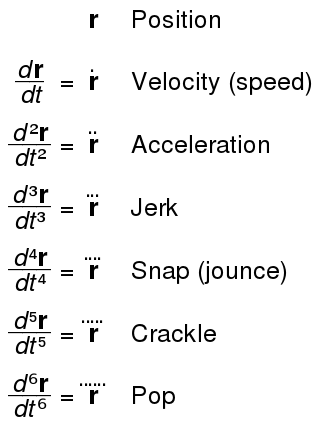Top Qs
Timeline
Chat
Perspective
Fourth, fifth, and sixth derivatives of position
Higher derivatives of the position vector with respect to time From Wikipedia, the free encyclopedia
Remove ads
In physics, the fourth, fifth and sixth derivatives of position are defined as derivatives of the position vector with respect to time – with the first, second, and third derivatives being velocity, acceleration, and jerk, respectively. The higher-order derivatives are less common than the first three;[1][2] thus their names are not as standardized, though the concept of a minimum snap trajectory has been used in robotics.[3]

The fourth derivative is referred to as snap, leading the fifth and sixth derivatives to be "sometimes somewhat facetiously"[4] called crackle and pop, named after the Rice Krispies mascots of the same name.[5] The fourth derivative is also called jounce.[4]
Remove ads
Applications
Summarize
Perspective
Minimizing snap and jerk is useful in mechanical and civil engineering because it reduces vibrations and ensures smoother motion transitions. In civil engineering, railway tracks and roads are designed to limit snap, particularly around bends with varying radii of curvature. When snap is constant, the jerk changes linearly, producing a gradual increase in radial acceleration; when snap is zero, acceleration changes linearly. These profiles are often achieved using mathematical clothoid functions. The same principle is applied by roller coaster designers, who use smooth transitions in loops and helices to enhance ride comfort.[1]
In mechanical engineering, controlling snap and jerk is important in automotive design to prevent camfollowers from jumping off camshafts, and in manufacturing, where rapid acceleration changes in cutting tools can cause premature wear and uneven surface finishes.[1] Minimum-snap and minimum-jerk trajectories is also used in trajectory generation in robotics. Minimum-snap trajectories for quadrotors can reduce control effort,[6] while minimum-jerk trajectories for robotic manipulators produce predictable motions that improve control performance and facilitate human-robot interaction.
Remove ads
.mw-parser-output .vanchor>:target~.vanchor-text{background-color:#b1d2ff}@media screen{html.skin-theme-clientpref-night .mw-parser-output .vanchor>:target~.vanchor-text{background-color:#0f4dc9}}@media screen and (prefers-color-scheme:dark){html.skin-theme-clientpref-os .mw-parser-output .vanchor>:target~.vanchor-text{background-color:#0f4dc9}}Fourth derivative (snap/jounce)
Summarize
Perspective
Snap,[7] or jounce,[2] is the fourth derivative of the position vector with respect to time, or the rate of change of the jerk with respect to time.[4] Equivalently, it is the second derivative of acceleration or the third derivative of velocity, and is defined by any of the following equivalent expressions: The following equations are used for constant snap:
where
- is constant snap,
- is initial jerk,
- is final jerk,
- is initial acceleration,
- is final acceleration,
- is initial velocity,
- is final velocity,
- is initial position,
- is final position,
- is time between initial and final states.
The notation (used by Visser[4]) is not to be confused with the displacement vector commonly denoted similarly.
The dimensions of snap are distance per fourth power of time [LT−4]. The corresponding SI unit is metre per second to the fourth power, m/s4, m⋅s−4.
Remove ads
Fifth derivative
Summarize
Perspective
The fifth derivative of the position vector with respect to time is sometimes referred to as crackle.[5] It is the rate of change of snap with respect to time.[5][4] Crackle is defined by any of the following equivalent expressions:
The following equations are used for constant crackle:
where
- : constant crackle,
- : initial snap,
- : final snap,
- : initial jerk,
- : final jerk,
- : initial acceleration,
- : final acceleration,
- : initial velocity,
- : final velocity,
- : initial position,
- : final position,
- : time between initial and final states.
The dimensions of crackle are [LT−5]. The corresponding SI unit is m/s5.
Remove ads
Sixth derivative
Summarize
Perspective
The sixth derivative of the position vector with respect to time is sometimes referred to as pop.[5] It is the rate of change of crackle with respect to time.[5][4] Pop is defined by any of the following equivalent expressions:
The following equations are used for constant pop:
where
- : constant pop,
- : initial crackle,
- : final crackle,
- : initial snap,
- : final snap,
- : initial jerk,
- : final jerk,
- : initial acceleration,
- : final acceleration,
- : initial velocity,
- : final velocity,
- : initial position,
- : final position,
- : time between initial and final states.
The dimensions of pop are [LT−6]. The corresponding SI unit is m/s6.
Remove ads
References
External links
Wikiwand - on
Seamless Wikipedia browsing. On steroids.
Remove ads














![{\displaystyle {\begin{aligned}{\vec {s}}&={\vec {s}}_{0}+{\vec {c}}\,t\\[1ex]{\vec {\jmath }}&={\vec {\jmath }}_{0}+{\vec {s}}_{0}\,t+{\tfrac {1}{2}}{\vec {c}}\,t^{2}\\[1ex]{\vec {a}}&={\vec {a}}_{0}+{\vec {\jmath }}_{0}\,t+{\tfrac {1}{2}}{\vec {s}}_{0}\,t^{2}+{\tfrac {1}{6}}{\vec {c}}\,t^{3}\\[1ex]{\vec {v}}&={\vec {v}}_{0}+{\vec {a}}_{0}\,t+{\tfrac {1}{2}}{\vec {\jmath }}_{0}\,t^{2}+{\tfrac {1}{6}}{\vec {s}}_{0}\,t^{3}+{\tfrac {1}{24}}{\vec {c}}\,t^{4}\\[1ex]{\vec {r}}&={\vec {r}}_{0}+{\vec {v}}_{0}\,t+{\tfrac {1}{2}}{\vec {a}}_{0}\,t^{2}+{\tfrac {1}{6}}{\vec {\jmath }}_{0}\,t^{3}+{\tfrac {1}{24}}{\vec {s}}_{0}\,t^{4}+{\tfrac {1}{120}}{\vec {c}}\,t^{5}\end{aligned}}}](http://wikimedia.org/api/rest_v1/media/math/render/svg/13172ed785d84cc18fbe636c060d7813f67a69d6)





